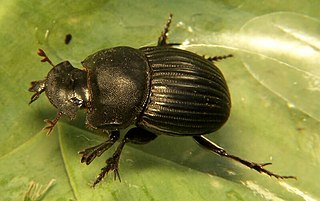
Bandipur National Park established in 1974 as a tiger reserve under Project Tiger, is a national park located in the Indian state of Karnataka, which is the state with the second highest tiger population in India. Along with adjacent Nagarhole National Park it is one of the Premier Tiger Reserves in the country. It was once a private hunting reserve for the Maharaja of the Kingdom of Mysore but has now been upgraded to Bandipur Tiger Reserve. Bandipur is known for its wildlife and has many types of biomes, but dry deciduous forest is dominant.

The scarab beetle subfamily Scarabaeinae consists of species collectively called true dung beetles. Most of the beetles of this subfamily feed exclusively on dung. However, some may feed on decomposing matter including carrion, decaying fruits and fungi. Dung beetles can be placed into three structural guilds based on their method of dung processing namely rollers, dwellers and tunnelers Dung removal and burial by dung beetles result in ecological benefits such as soil aeration and fertilization; improved nutrient cycling and uptake by plants, increase in Pasture quality, biological control of pest flies and intestinal parasites and secondary seed dispersal. Well-known members include the genera Scarabaeus and Sisyphus, and Phanaeus vindex.

Copris is a genus of dung beetles in the tribe Coprini of the scarab family. It comprises more than 250 tunnelling species and has an almost worldwide distribution.
The Copenhagen Peace Research Institute (COPRI) was a Danish research institute established in 1985 by the Danish Parliament. Its aim was to support and strengthen multidisciplinary research on peace and security. Established as an independent institute, in 1996 it became a government research institute under the Ministry of Research and Information Technology. In January 2003, COPRI was merged into the Danish Institute for International Studies.
Prevotella is a genus of Gram-negative bacteria.

Coprini is a tribe of scarab beetles, in the dung beetle subfamily (Scarabaeinae). Scholtz et al. describe them as tunnellers that are shiny black, of moderate to large size and with a strongly convex shape. They also, however state that the grouping based on these characteristics has little phylogenetic validity, and the placement of several genera in this and related tribes is likely to change.
Copris howdeni, or Howden's copri, is a species of dung beetle in the family Scarabaeidae.

Copris fricator is a species of dung beetle in the family Scarabaeidae.
Copris remotus is a species of dung beetle in the family Scarabaeidae.
Gozmanyina majestus is a species of cosmochthoniid in the family Cosmochthoniidae.
Spilomyia crandalli is a species of syrphid fly in the family Syrphidae.
Copris minutus, the small black dung beetle, is a species of dung beetle in the family Scarabaeidae. It is found in North America.

Protenor is a genus of broad-headed bugs in the family Alydidae. There are at least three described species in Protenor.

Copris caobangensis is a species of dung beetles described in 2018. The holotype was collected in Pia Oac Nature Reserve, Caobang Province, Vietnam at an altitude of 1210–1230 m in 2017.
Exochocepheus eremitus is a species of mite in the family Scutoverticidae.
Copris lecontei is a species of dung beetle in the family Scarabaeidae.

Hypselonotus punctiventris, the spot-sided coreid, is a species of leaf-footed bug in the family Coreidae. It is found in Central America and North America.

Copris arizonensis is a species of dung beetle in the family Scarabaeidae.

Dichotomius carolinus, the Carolina copris, is a species of dung beetle in the family Scarabaeidae.








